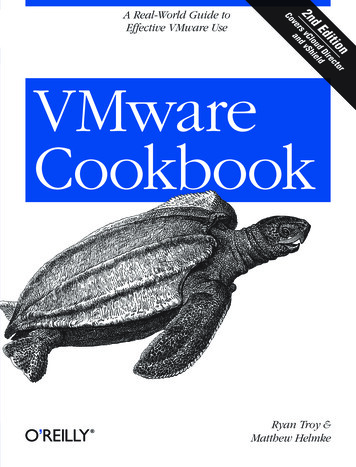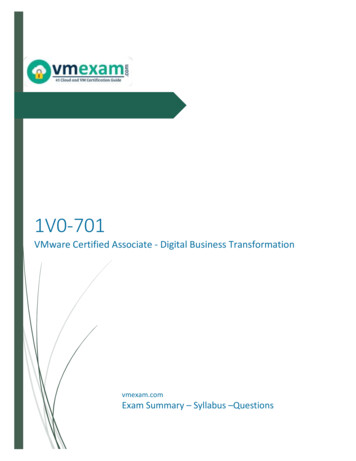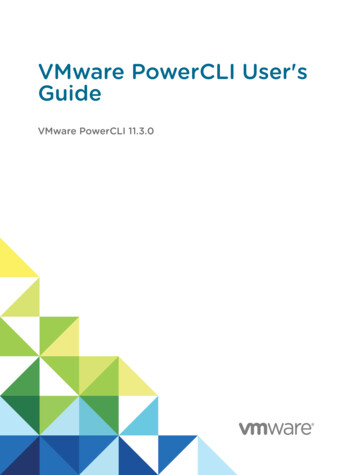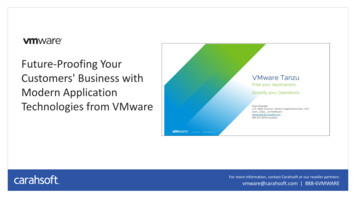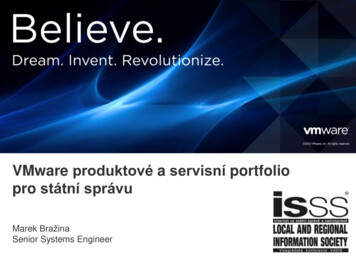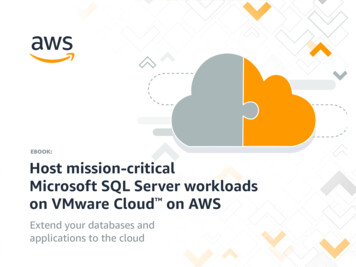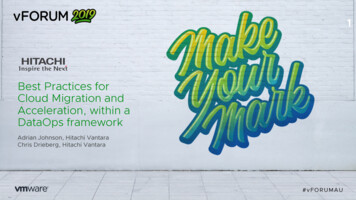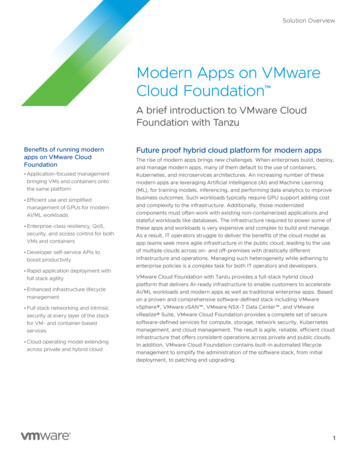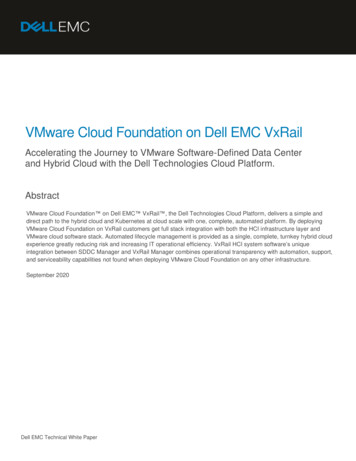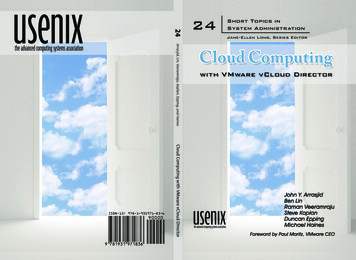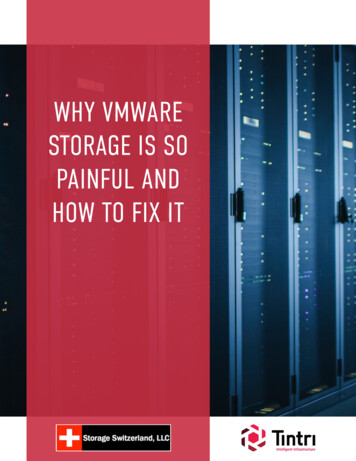
Transcription
WHY VMWARESTORAGE IS SOPAINFUL ANDHOW TO FIX IT
Since the advent of the all-flash array, manyvendors have declared VMware storageinfrastructure problems solved. As a result,many vendors have moved on to other more“glamorous” projects like Artificial Intelligence,Machine Learning, and NoSQL workloads. Whilethose projects are undoubtedly important, theVMware infrastructure is still the heart and soul ofmost organizations, and for many organizations,it is THE environment. The reality is that tuning,managing, and efficiently utilizing storage is stillthe most painful part of the VMware storageinfrastructure. These issues are also potentially themost significant inhibitor to scaling theVMware Infrastructure.
WHY VMWARESTORAGE IS STILLA PROBLEMMost VMware storage solutions attempt to fix storagepain points with a sledgehammer instead of a scalpel.While the sledgehammer approach does solve or at leastmask some VMware storage problems, many still remain.More importantly, the life of the IT professional tasked withmanaging the VMware storage infrastructure the same waythey always have didn’t get any easier as a result.
THE ALL-FLASH SLEDGEHAMMERAll-flash arrays, especially as they become increasingly affordable,help IT professionals solve one of their biggest challenges,VMware’s infamous IO blender. The IO blender is the result ofmultiple physical servers, each populated with potentially dozensof virtual machines continuously access the storage system, whichbecomes a choke point. Instead of prioritizing workload IO, theall-flash system resolves the issue by responding much quicker toIO demands than hard disk or hybrid systems can.Like most sledgehammers, all-flash seems to solve the problem,but as the environment continues to increase virtual machinedensity and mix workload types, the IO blender problemcreeps back in. IT professionals quickly learn that lower latencyinfrastructure is only part of the answer. Storage systems haveto use all of their resources intelligently to provide balancedconsistent performance. All-Flash arrays alleviate some of theIO blender problem because they reduce latency, not becauseVMware can tap into their raw IOPS capability. The lack of anintelligent storage system forces the organization to either notvirtualize some workloads or to dedicate certain types of storagesystems for each workload type.The result is a management nightmare for IT professionals. Theyare having to constantly rebalance workloads across the variousstorage systems supporting the infrastructure and are in the darkabout how the next new workload will impact the performanceof the currently running virtual machines. For example if theorganization decides to virtualize a bare metal MS-SQL clusterthe VMware administrator not only doesn’t know how muchavailable resources they have they also can’t measure the impactof virtualizing the new workload. The only “alert” available is whenuses start complaining about performance.
THE HYPERCONVERGED SLEDGEHAMMERAnother attempt at addressing VMware’s IO blender problemis Hyperconverged Infrastructure (HCI). HCI approachesvary but typically, they work by running a component of thestorage software on the same hardware as the hypervisor andvirtual machines (VM). They also keep a copy of each VM’sdata locally on the server that is hosting the VM, as well asa distributed copy for data protection and to facilitate VMmobility. Ideally, the local copy facilitates all read IO, whichreduces network traffic and the impact of the IO blender.Additionally, an increasing number of HCI architectures arealso all-flash, further reducing the creation of an IO blendereffect.HCI scales by adding additional physical servers, typicallycalled nodes, to the hypervisor cluster. Each node includescompute, memory, networking and storage. The problem isthat most data centers don’t scale all of these components inlock step. Usually, each organization tends to need significantlymore of one type of resource, than another type given thediversity of applications. For example, if the organization needsmore storage, it buys a node with it to meet that need, but thatnode also comes with all the other resources as well, and thoseresources go unused. Additionally, each time IT adds anothernode to the hypervisor cluster, complexity increases, especiallyon the network.HCI hits the VMware IO blender problem with an even biggersledgehammer. It does leverage some intelligence by reducingthe amount of read IO on the network but it increases theimpact of write IO on the network. HCI sacrifices efficiency in itsattempt to eliminate the IO blender.THE INNOVATION THAT VMWARESTORAGE NEEDSAddressing VMware challenges like the IO blender, increasingVM density and efficiently leveraging more powerful serversrequires intelligent application of infrastructure resources end toend, a deep awareness of the VMware operating environmentand efficient scaling of storage capacity and performance.Instead of a generic system designed for a multitude ofworkloads that might happen to include VMware, IT shouldconsider a storage system purpose built for VMware.Our next chapter details how VMware aware storage systemsthat operate at the VM, which is the atomic unique of aVMware environment, provide not only taking action on specificVMs but also empowers learning based on behavior of the VMand the VMs, visibility and control. The result is significantlymore efficient systems that provide better overall performanceand significantly reduces administration time.
VMWARE STORAGENEEDS INTELLIGENCEAND AWARENESSFOR A DIFFERENTEXPERIENCEVMware continues to be at the heart of many data centerinfrastructures and will continue to be that heart for years, ifnot decades, to come. Many of these infrastructures are stillstruggling however with the most basic of data managementand data protection functions. All-Flash arrays may havealleviated some of the infamous IO blender issue but thereare still many more storage challenges to tackle. Two keychallenges and areas for innovation are gaining insight intothe storage IO demands and behaviors of each specificvirtual machine as well as the need to better predict and planfor scale.
FROM VISIBILITY TO INSIGHTDEALING WITH SCALEMost storage systems that support VMware environmentsare block-based, which by default provide no visibility into thespecific virtual machine (VM) IO activities. In 2015, VMwaredelivered a feature called VVOLS that provided increased VMvisibility but with limited ability to respond rapidly to specificIO conditions. VVOLS is still volume based and requires thecreation and management of volumes. An alternative is to usea file-system based storage architecture, which, because VMsare essentially files, provides visibility into each VM’s IO profile.One reality that almost every VMware administrator andthe infrastructure admins that support them must deal withis scale. Either the current storage system will run out ofstorage capacity or it won’t be able to keep up with storageIO demands. Scaling typically means adding another storagesystem and migrating workloads to the new system so that theold one can be retired. Several vendors have brought out scaleout storage solutions or scale-out hyperconverged solutionsto address the scaling problem but these environments tendto start too large, don’t scale granularly enough and put extrapressure on the storage network. A more intelligent approachis a system that can scale up by adding additional storagecapacity and then scale-out by adding additional storagesystems. The second storage system can start small and havecapacity added to it as the need demands.Visibility into each VM’s IO profile is an improvement overblock-based storage, but to take full advantage of this granularview of VM storage, it requires more than just loading VMs ona NFS volume. The storage system needs to have intelligentsoftware built-in that performs a continuous analysis of eachVM’s IO pattern, storage capacity consumption rate andprovides predictive forecasting / modeling of future use. Armedwith this insight, IT can easily respond to complaints aboutstorage performance and either take corrective action or provethat storage is not the source of the bottleneck.FROM INSIGHT TO LEARNINGInsight into the IO characteristics of a specific VM enables ITto more quickly and precisely intervene when problems arise.Intelligent infrastructure learns from that analytics captured,allowing the system to take corrective action on its own. Basedon the analysis, it should be able to take corrective actioneither to mitigate outages or to meet changing performancedemands. Applying machine learning to the data the storagesystem already collects enables organizations to avoidspending all day manually monitoring and managing storage.The typical problem with adding multiple storage systemsis managing them and figuring out which VMs IT needs tomigrate to the new system. Storage systems need innovationso that IT can forecast, by using the methods described above,when the need for a new storage system will occur. There isalso a need for innovation in automating which and how VMsmove to the new storage system since in most cases, the currentsystem still has years of reliable service left. Trying perform amigration, at-scale, between systems that are not VM aware ismuch more difficult, time consuming and more than likely willimpact production applications.Armed with an intelligent scale-out capability IT can buy anew storage system that performs much better but initially hassignificantly less capacity then the current system. The storagesoftware can then leverage the analytics information to movethe most viable candidates automatically, to the new system.This automate process frees up capacity on the current systemwhile improving the performance of VMs that need it.CONCLUSIONIn order to enable IT professionals to focus on tasks that more directly and positively impact the organization,they need technology that manages itself. The storage system and infrastructure are an excellent starting point.With proper intelligence software, a VM aware system can deliver valuable telemetry data that IT can use tomanage storage better. The endgame though, is to have the storage system teach itself from this telemetry dataand automatically take corrective measures, freeing IT to work on higher level tasks.
VMWARESTORAGE TABLESTAKES ARE NOTINNOVATIONSAny IT planner looking to refresh their VMware storageinfrastructure will undoubtedly speak with multiple storagevendors who talk endlessly about IOPS and cost pergigabyte. The problem is, these so-called features don’t makethe IT team’s job any easier. Indeed, high IOPS may meanthe application performs faster, but faster doesn’t make iteasier to operate. In the same way, a low cost per gigabytemay make the solution more affordable, but lots of cheapcapacity doesn’t make the system easier to manage. In fact,in some cases, excess capacity makes it more complicated.
While IOPS and affordability are an essential aspect of any storagerefresh, most vendors can get within a range of each other in thesetwo categories. IT planners should instead be looking for a storagesystem that increases VMware’s usability while at the same timeimproving IT operations efficiency. A storage system can improveVMware usability by proactively managing IO so that more virtualmachines (VM) can run per physical server, and more physical hostscan connect to the same storage system. Both of these capabilities,though, require a storage system that can analyze and intuitivelyadapt to changing conditions. A storage system can improve ITefficiency by providing clear, real-time insight into storage systemtelemetry data and automating mundane tasks.IT STARTS WITH A FILE-SYSTEMBlock storage systems, long the mainstay of VMware storageinfrastructure, are challenging to manage and don’t provide thelevel of insight that IT operations need to maintain a busy VMwareenvironment effectively. Organizations, to keep some simplicity, canplace all VMs on a single logical unit number (LUN). The problemis that per VM visibility is lost, making management more difficult.Alternatively, IT can create a separate LUN for every VM.Features like VMware’s VVOLs simplify the VM per LUN process abit but still don’t provide the level of granularity that most storagemanagers want. File-systems, on the other hand, do ensure a highlevel of insight without impacting performance. File-Systems storeevery VM on a single volume, and each VMs datastore is accessibleand visible to monitoring tools. The file-system can’t be just any filesystem though. It needs to be specifically designed for the VMwareuse case so that performance and other integrations are optimized.A purpose-built file system for VMware enables deep integrationwith the entire ecosystem. More importantly, it needs to leverage theper-VM visibility and via machine learning, proactively manage thestorage infrastructure
QUALITY OF SERVICECAPACITY PREDICTIONSWhen trying to maximize the VMware investment, IT plannerswant to achieve the highest virtual machine density possible,and they want the storage system to support as many physicalservers in the ESX cluster as possible. At a base level, all-flasharrays help organizations reach these goals, but even anall-flash array, under these highly-dense conditions can hit aperformance wall if it is not optimized.Another challenge facing highly optimized VMwareenvironments is capacity planning. These environments tend togrow continuously and are adding new VMs multiple times aday. Of course, each of these VMs need to store data and cancause the storage system to run out of capacity if IT does notcarefully monitor its consumption.Organizations looking to maximize server host and VMdensity need quality of service (QoS) to make sure the mostcritical workloads get priority access to the storage system’sperformance. However, the system should go beyond justletting administrators preset QoS levels and also leveragemachine learning to determine normal performanceparameters and make sure the VM remains inside thoseboundaries. The proactive QoS capability ensures that arunaway VM doesn’t take performance away from a moremission-critical VM.The problem is administrators of highly optimized VMwareenvironments may be too busy to monitor their storageutilization constantly. Instead, the storage system needs toprovide administrators with proactive analytics to help themdetermine in advance when the storage system will run out ofcapacity. This advanced knowledge means that organizationsdon’t have to over-provision their storage systems, paying inadvance for storage they won’t use for months or even years.DATA PROTECTION BUILT-INCONCLUSIONBackup should be part of every data protection strategy,but if IT is recovering from backup, it means that makingrecovery point and recovery time objectives are at risk. TheVMware storage system needs built-in protection. It shouldtake advantage of the VMware granularity, and be able to setdifferent snapshots and replication schedules per VM.Innovation in VMware storage is no longer IOPS or low price.Those are table stakes. VMware storage focuses on reducingIT operations overhead by proactively responding to VMwareenvironmental conditions based on machine learning.
Storage Switzerland is the leading storage analyst firm focused on theemerging storage categories of memory-based storage (Flash), Big Data,virtualization, and cloud computing. The firm is widely recognized for itsblogs, white papers and videos on current approaches such as all-flasharrays, deduplication, SSD’s, software-defined storage, backup appliancesand storage networking. The name “Storage Switzerland” indicates a pledgeto provide neutral analysis of the storage marketplace, rather than focusingon a single vendor approach.Based in Silicon Valley, Tintri is a wholly owned subsidiary of DataDirectNetworks (DDN), the data-at-scale powerhouse and world’s largest privatelyheld storage company. Tintri delivers unique outcomes in Enterprise datacenters. Tintri’s AI-enabled intelligent infrastructure learns your environmentto drive automation. Analytical insights help you simplify and accelerate youroperations and empower data-driven business insights. Thousands of Tintricustomers have saved millions of management hours using Tintri. Choosedifferently, the choice is yours. Where will you invest your resources toincrease the scale and value of your business?Learn more about the Tintri portfolio of solutions athttps://www.tintri.com/products.
Any IT planner looking to refresh their VMware storage infrastructure will undoubtedly speak with multiple storage vendors who talk endlessly about IOPS and cost per gigabyte. The problem is, these so-called features don't make the IT team's job any easier. Indeed, high IOPS may mean the application performs faster, but faster doesn't make it


